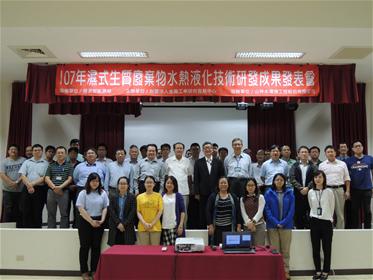
Taiwan has been proactively promoting the development and application of waste-to-energy technologies in order to facilitate the development of biomass energy technologies in the country while achieving multiple goals, such as distributed generation of baseload power, waste treatment, carbon reduction, and a circular economy. In 2018, the Bureau of Energy commissioned the Metal Industries Research and Development Centre (MIRDC) to carry out “Development of Thermochemical Liquefaction Technology Using Wet Bio-wastes”. While carrying out the project, the MIRDC and its technical partner, Forest Water Environmental Eng'g Co., Ltd., proved that the conversion of sewer organic sludge into biofuels may reduce handling cost, the consumption of fossil fuels, and greenhouse gas emissions while expanding the application of biomass energy.
The presentation was held at Nanzih Wastewater Treatment Plant on October 29, 2018. During the presentation, the MIRDC briefed on the outcomes achieved this year in developing high-pressure hydrothermal liquefaction technologies. A city generally produces about 110,000 tons of sewer organic sludge each year. Using the self-developed high-pressure hydrothermal liquefaction technologies, the sewer organic sludge with high water content (80-90%) can be converted into biofuels within 30 minutes, which efficiently solves waste treatment problems and facilitates the utilization of renewable energy.
With the support of the Bureau of Energy, the MIRDC has been proactively integrating the industrial, academic, and research resources in Taiwan and striving to come up with industrial solutions. With systemic considerations ranging from urban wet biomass waste, hydrothermal liquefaction of biomass, to application of biofuels, the MIRDC puts its focus on theoretical analyses, crucial modules, promotions, and applications to continuously promote the development of hydrothermal liquefaction technologies and facilitate industrial applications of various types of biomass energy in Taiwan to connect to international trends.